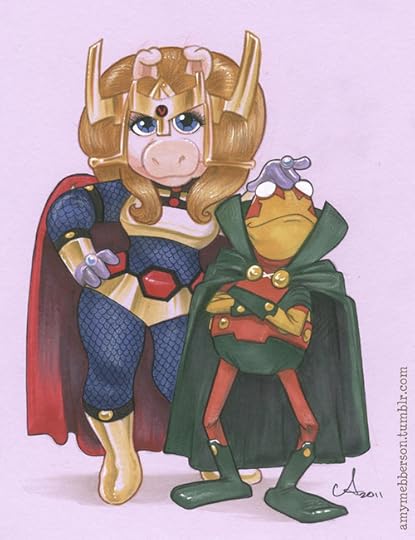Tansy Rayner Roberts's Blog, page 88
February 12, 2013
Glitter & Madness Author Q&A – Tansy Rayner Roberts
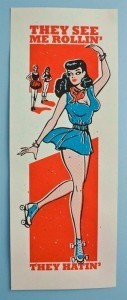 The Glitter & Madness Kickstarter is now past $9,000 and gaining steam! This also means that two vids have been released: the Scary and the Swank. Check them out!
The Glitter & Madness Kickstarter is now past $9,000 and gaining steam! This also means that two vids have been released: the Scary and the Swank. Check them out!
Lynne, Michael & John have asked the authors attached to this project to do a little Q&A to talk about what they have written for the book. Here’s mine:
1. What about the theme drew you to the anthology?
Rollerskates! Glamour! I’ve been a teeny bit wild about roller derby since I read Derby Girl by Shauna Cross (the book that was turned into the awesome Whip It! movie) and this anthology just sounded so exciting to be part of.
2. We’re often told to write what we know. Did you draw your G&M story from your own nightlife experiences?
I was totally at a private party at a club on Saturday night, dressed as Batgirl, and watching Iron Man dance up a storm with Poison Ivy… though for full disclosure I feel I have to admit that most of the people at said party were 30 and 40 somethings telling each other that ‘we don’t get out much these days since the kids.’
It was still pretty awesome, though, and we had superhero cocktails. “The Fury” was a most excellent concoction. Also this is where I discovered that Long Island Iced Tea has no tea in it.
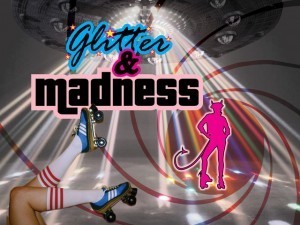 3. What’s your favorite way to make life more glittery?
3. What’s your favorite way to make life more glittery?
Killer playlists! Everything is glitter when there’s a solid soundtrack going. I’m just getting back into using music when I write, something I learned back in my early nanowrimo days, and it makes the typing so much more fun!
Also, I have to say, don’t discount the usefulness of actual glitter.
4. If you had to create a cocktail that reflected your story, what would it be?
Is there some way to add vodka to an icecream sundae? Oh, how about the ‘Crash Course’ – you take a pina colada and keep adding lemon sherbert until it explodes. THAT.
5. If you knew you were up for a surreal evening, what and whom do you bring with you, and why?
My iPhone for documentation and communication, a pair of comfortable shoes, and Wonder Woman. Unless the evening is zombie themed in which case I would take a handbag full of carnivorous plants.
The Glitter and Madness Kickstarter closes in a few days – if the anthology sounds like something you want to read, and you haven’t backed it yet, please consider doing so!
February 11, 2013
Glitter Madness Update
 The Kickstarter for Glitter Madness is in its last week, and opened for submissions once it passed the 50% mark.
The Kickstarter for Glitter Madness is in its last week, and opened for submissions once it passed the 50% mark.
The brains behind this project have promised to start posting fun and possibly embarrassing glitter & roller derby themed vids if we reach the $8000 and $9000 marks tonight. And oooh I see that we’ve JUST got over the $8000 mark that’s exciting!
Also if this anthology goes ahead, it means you will get to read my glittery roller nightclub Minotaur story. You know you want to… please donate if you can! It’s going to be an awesome book.
As you know, we’ve got fabulous work from amazing writers like Alan DeNiro, Amal El-Mohtar, Daryl Gregory, Damien Walters Grintalis, Maria Dahvana Headley, Kat Howard, Seanan McGuire, Jennifer Pelland, Tim Pratt, Cat Rambo, Tansy Rayner Roberts, Diana Rowland, Sofia Samatar, David J. Schwartz, William Shunn, and Rachel Swirsky.
But what about you? You’re glamorous, right? We bet you have a dazzling idea for a story, don’t you? You probably even know the prompt by heart:
Roller Derby, nightclubs, glam aliens, (literal) party monsters, drugs, sex, glitter, debauchery, etc.
Well, if you aren’t already writing, you should start now!
Here’s the details you’ve been waiting for:
The max word limit is 6000 with a deadline of March 15.
We’re paying $.05 per word.
You’ll have the chance to be edited by Hugo Award-winning editors and be in a ToC with awesome authors (see above).
We can’t wait to see what you create. Surprise us. Amaze us. Dazzle us.
We expect stories to follow standard manuscript format. We expect that the your name and contact info is on the first page of your submission. Please send only one submission at a time. If you can refrain—mostly due to the extremely short reading period—please do not query about your submission.
Ready? Then go right to the anthology’s submission page!
Eldrad Must Live! [WHO-50—1976]
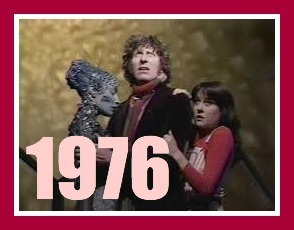 The Hand of Fear, Sarah Jane Smith’s farewell story of the classic series, is a favourite of mine, and I’ve never really stopped to think about why. In many ways it feels like a very ordinary story, ticking a lot of the boxes of Pertwee-Baker Earthbound serials, without even a UNIT chappie or two to liven things up.
The Hand of Fear, Sarah Jane Smith’s farewell story of the classic series, is a favourite of mine, and I’ve never really stopped to think about why. In many ways it feels like a very ordinary story, ticking a lot of the boxes of Pertwee-Baker Earthbound serials, without even a UNIT chappie or two to liven things up.
I think that a big part of the appeal of this one for me is that the story revolves around Sarah as the companion, and has a greater effect on her than most of her later stories had. It might be paced like the old show (and how), but it has a gleam of what we would get in New Who – stories where the companion’s feelings and reactions to things were basically the point of the plot.
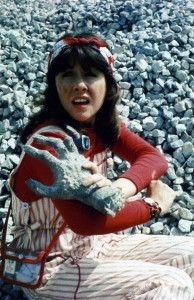 As the story opens, we get the deliciously meta scene in which Sarah and the Doctor step out on to the surface of another grey, rocky alien planet filmed in a location quarry… only to realise after a bit of walking that they are in fact in a QUARRY and those sirens mean the explosives are about to go off! More to the point, it’s Sarah who realises this first.
As the story opens, we get the deliciously meta scene in which Sarah and the Doctor step out on to the surface of another grey, rocky alien planet filmed in a location quarry… only to realise after a bit of walking that they are in fact in a QUARRY and those sirens mean the explosives are about to go off! More to the point, it’s Sarah who realises this first.
While the recovery scenes of this, with the Doctor searching for Sarah in the rubble and her being rescued are from his POV, she isn’t playing the victim for long… well, not exactly! We follow her closely as she becomes hypnotised/possessed by the mysterious fossilised hand that was exposed in the rubble, and see how this close relationship with the artefact expands later into a complicated, wary relationship with the alien woman Eldrad who returns to life thanks to Sarah’s theft of the hand.
I also really like the possessed Sarah scenes in this – the horror tropes are being used like crazy, but she never feels weak in this storyline, her personality shining through even when she is controlled by something else.
Eldrad is one of those rare alien characters in the show who feels and looks truly alien – the gorgeous prosthetic work puts her design up there with the Draconians, and I remember as a child being fascinated by the whole notion of a silicone based life form.
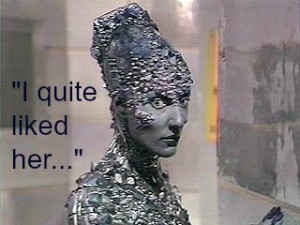
There are some interesting ethical issues explored in this story, and Eldrad’s femininity and beauty are used to put the Doctor and Sarah off their guard, to help them sympathise with her plight as a stranded alien desperate to return home, despite the fact that she’s holding them hostage.
What I remember most about this story is the interplay between Eldrad and Sarah – the implication is certainly that while Eldrad has compelled the Doctor to do her bidding, he isn’t falling for her sob story, whereas Sarah is much more mixed in her responses.
Then Eldrad is destroyed… and returns in a male form. The Doctor suggests that Eldrad only took on the female form in the first place because Sarah was the first life form he came across, which seems a bit dubious (perhaps if made as a New Who story, Elisabeth Sladen would play both parts) but I think it’s interesting that the character is so very different in the two gendered forms – the female Eldrad is cool, calculating and persuasive, while the male Eldrad is a wild and violent thug.
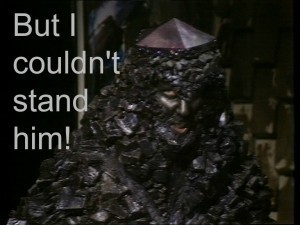
At the end of it all, there’s that scene, one of the sweetest and most genuine classic companion leaving scenes – in which Tom Baker and Elisabeth Sladen threw out the script to decide for themselves what needed to be said!
Her armful of “goodies” to take home tells us a lot about the amount of time she has been there, and how she has set up home in the TARDIS despite never having meant to move in on a permanent basis… and if you’ve never seen the Australian gay SF fan sitcom, it’s absolutely worth tracking down episode 2 to see a gloriously subtle homage to Sarah’s armful of stuff.
(That will never make me not laugh, John Richards!)
While it was a deliberate move (and Sladen’s request) not to make Sarah’s final story specifically about her, I think it’s pretty cool that she was given so much to do in this one, and that it turned out to be a story about gender expectations as well as trying to help an ungrateful alien find her way home – which was to become a staple plot of The Sarah Jane Adventures.
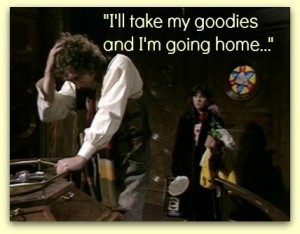
After coming up this in the Verity! Podcast discussion threads, I have decided my new head canon is that the Fourth Doctor’s pronouncement “I can’t take Sarah to Gallifrey” has nothing to do with Time Lord regulations or the threat of The Deadly Assassin, and instead is because he doesn’t want the Time Lords exposed to the concept of investigative journalism. It wouldn’t be good for them!
Though in another version of reality, Sarah runs a tabloid newspaper on Gallifrey, running articles about Andred and Leela’s role in the city guard, interviewing the sand-dwellers outside the city, and writing scathing editorials about Romana I’s latest election campaign…
I miss Sarah Jane Smith. Still. She was the absolute best at making you believe that everything that happened in the Doctor Who universe was real. No wonder they brought her back, over and over. She is irreplaceable.
ELSEWHERE IN 1976:
The Brain of Morbius 1 2 3 4 [The Chronic Hysteresis]
The Seeds of Doom [Wife in Space]
The Masque of Mandragora (AKA the one where they find the wooden console room) [Wife in Space]
Next Stop: Aberdeen [Radio Free Skaro]
Sarah Jane Smith (art) [Springfield Punx]
Verity!Extra! and the Andy Pandy Overalls Revelation [tansyrr.com]
The Deadly Assassin [Mindless Ones]
February 10, 2013
Burnout and Recovery: When Publishing Hurts Writers
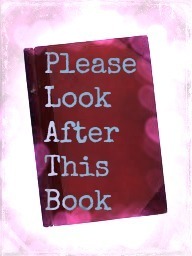 This post by Kameron Hurley on how she dealt with the burnout that comes from writing a series (itself an exhausting thing, especially towards the end) for a publisher who has let her down in many ways.
This post by Kameron Hurley on how she dealt with the burnout that comes from writing a series (itself an exhausting thing, especially towards the end) for a publisher who has let her down in many ways.
It’s not a post you see very often. Authors still tend to feel vulnerable about airing their bad experiences in public, worrying that this lack of solidarity will get them a bad reputation in the industry.
But keeping quiet can be more damaging. Not just to the other writers you fail to warn, but also to your own sense of self, and to your writing. If all writers talk about is the good experiences, we are not only letting each other down (by pretending everything is rosy) but ourselves.
We’re not always the hardbitten hacks we pretend to me – even the toughest of us do have at least one layer of self conscious, self-doubting fragile snowflake, and one bad experience can make it incredibly hard to pull up our boots and keep working like nothing has happened. Our business is emotional, and that can take a mighty toll on the work itself. Which SUCKS BEYOND BELIEF.
Good books fail in the marketplace all the time, and bad books do great. But I agree very much with Kameron that the most frustrating thing can be when a book is let down by the very people who are supposed to be promoting and supporting it.
Being robust is really, really hard.
I’ve had so many frustrations in my own career, but even more frustrating is seeing my friends, bowed down by a bad experience, even finding their own writing suffer because why would you write at your best if you’re contractually tied to a publisher who doesn’t respect you, or pay you, or promote you?
Why is it so much easier to get angry about friends being treated this way, and not ourselves? I’ve been where Kameron is (or somewhere very similar) and it messes with your head, makes you think that actually a year’s work on a book you have sweated blood over may not be worth the paper it’s printed on.
I think this piece is particularly important because it talks how she got through this bad time, and the benefit she found from separating money and financial dependence from her writing, in order to give herself a chance to heal and get back to writing for love again. It’s a really important lesson, because writing full time (or writing as an essential income stream) is not just this Holy Grail where someone pays you to do your favourite thing in the world – sometimes it can be a terrible pressure. There’s a big difference between your hobby or passion being work, and your passion BECOMING WORK.
I don’t in any way rely on my writing income to keep my family’s head above water, but I do rely on it for my sense of independence and justification for the family resources I use to make my writing happen – not earning anything becomes stressful, and that makes writing harder. Vicious circle or what? I have a big trip coming up later this year which is largely career-based (WFC!) and knowing how much money is coming out of the mortgage to make that happen is Supremely Stressful!
Don’t think that linking to the post is about bashing publishers, though, or Kameron’s publisher in particular. Publishers should absolutely be accountable for how they treat authors, but this isn’t just about how some publishers behave badly and some have room to improvement. I think the important takeaway message from this is for writers to recognise how vulnerable they can be in these situations. We can’t pretend that things like this don’t happen. Getting through it, and progressing despite the latest blow, is the hardest part of being a writer.
Our industry has always been full of ups and downs, but lately it seems we have to deal with round and rounds and sideways spirals and screaming rollercoasters driven by hallucinating pandas, which is terrifying and exciting and horrible all at once.
Sometimes the answer is to go it alone and self publish, but that isn’t the answer for every author or every book. Sometimes the answer is to find a really great publisher and editor and agent, but what happens when they fold, resign and retire all in the same week?
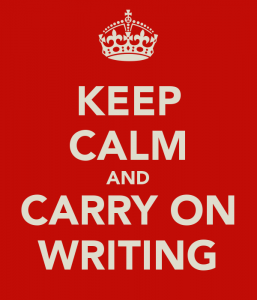 Good publishers, and good editors, and good publicists, are treasures to writers. And we are terribly grateful when we get them – at least, I know I try to be! I have spent the week (my first week of Ms8 back at school!) proofing A Trifle Dead, taking enthusiastic and strange emails about publicity plans, and volunteering for all kinds of madcap notions. My current publisher may not be “big” by any stretch of the imagination (and in Australia big/small press is so laughably different to the US definitions that we seriously need different words, maybe Lilliputian and Micro-Lilliputian) but right now they are taking care of me, and I feel terribly grateful for that.
Good publishers, and good editors, and good publicists, are treasures to writers. And we are terribly grateful when we get them – at least, I know I try to be! I have spent the week (my first week of Ms8 back at school!) proofing A Trifle Dead, taking enthusiastic and strange emails about publicity plans, and volunteering for all kinds of madcap notions. My current publisher may not be “big” by any stretch of the imagination (and in Australia big/small press is so laughably different to the US definitions that we seriously need different words, maybe Lilliputian and Micro-Lilliputian) but right now they are taking care of me, and I feel terribly grateful for that.
But I have my damage from previous publishers, some mild and some which has left some serious scarring. I have a great relationship with Twelfth Planet Press, but having a publisher or editor who is also your friend brings a whole new level of ‘more to lose’, which is scary. (Alisa and I have had a couple of near miss fights, but come through it still respecting each other, which is so important)
It’s so much easier to write the next book when you know there’s someone at the other end of your email who will smile when they receive it… and treat it with kindness and respect as well as professionalism as they take it to the marketplace. (Though obviously they are allowed to be mean at the editorial stage.) But being a writer is always about taking risks, and trying new things. Not every publisher will be good to you, or your friend, or the best fit for you, and even if you find the Best Publisher Evah it’s a bad idea to put all your eggs in one basket. It’s heartbreaking at times, losing books to contracts that turn out to be less than ideal. But we keep on keeping on.
Never be afraid to ask your fellow writers what their experience with a publisher has been. Even if their experience has been 100% positive, they will know why you are asking. If we don’t talk to each other – whether in private conversations or in the public way that Kameron Hurley has chosen – then we are missing out on a great opportunity to demand better treatment for ourselves, our colleagues in the industry, and our books.
February 7, 2013
Friday Links Was Found under a Car Park
 Richard III took over my Twitter feed this week – is it just me who resists finding out the actual details of a news story so as to enjoy the surrealism of the tweets that assume you know what they are talking about?
Richard III took over my Twitter feed this week – is it just me who resists finding out the actual details of a news story so as to enjoy the surrealism of the tweets that assume you know what they are talking about?
I particularly enjoyed Brian Blessed weighing in about the discovery of his “dear old dad” only to later correct it to “uncle.” (Twitter, of course, is still correcting him several days later. Oh, Twitter, don’t ever change.)
If you haven’t heard about the reason why everyone is talking about Richard III this week, then you can check out this piece on the Huffington Post which explains things. It’s pretty cool, as all rockstar moments of archaeology tend to be.
In your FACE, William Shakespeare!
It’s women in horror recognition month, which means it’s time to sign up to the Stranger With My Face 10×10 challenge – can you write a 10 page horror script in 10 days? Bonus points for non-sucky representation of women!
In other Women in Horror February news, Ann Radcliffe is awesome.
You all need a new podcast, right? Something challenging and crunchy and inspiring? Well, look no further than Cheryl Morgan’s Small Blue Planet, which aims to explore the SF happenings (both fandom and professional) in countries where English is not the dominant language. Cheryl talks about her ideas for the project here. The first episode spotlights Finland, interviewing critic Jukka Halme and translator Marianna Leikomaa (both of whom have run conventions) about all kinds of things, including a Worldcon bid for Helsinki. I found it fascinating, a great way to look at cultural and linguistic differences. The February episode will look at China, and the March episode will look at Brazil.
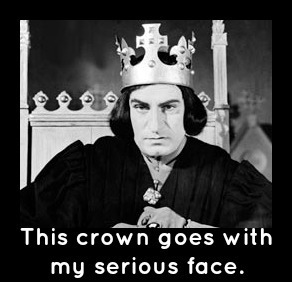 Sarah Rees Brennan talks about recent developments in the Lizzie Bennet Diaries (they’re up to the really juicy stuff!) and the clever way that this web series has incorporated women’s work, education and careers (as well as entrepreneurial spirit) into the story, where only marriage made sense in Austen’s time. I’ve been really impressed by this (and am desperately hoping Lydia gets a better and more feminist ending than Austen gave her, not least because this Lydia is adorable and brilliant and deserves better for herself) myself, and how well the story stands up even with the separation of romance and business interests (though issues such as social climbing and marrying for security are still acknowledged along with the question of selling out in a career/artistic sense – the Charlotte arc has been particularly clever).
Sarah Rees Brennan talks about recent developments in the Lizzie Bennet Diaries (they’re up to the really juicy stuff!) and the clever way that this web series has incorporated women’s work, education and careers (as well as entrepreneurial spirit) into the story, where only marriage made sense in Austen’s time. I’ve been really impressed by this (and am desperately hoping Lydia gets a better and more feminist ending than Austen gave her, not least because this Lydia is adorable and brilliant and deserves better for herself) myself, and how well the story stands up even with the separation of romance and business interests (though issues such as social climbing and marrying for security are still acknowledged along with the question of selling out in a career/artistic sense – the Charlotte arc has been particularly clever).
What I hadn’t realised until Brennan pointed it out was the massive difference (and improvement) this makes to the Lizzie/y & Darcy romance – whereas in the original he learns to appreciate her as a person (and grows to find her more attractive the better he gets to know her personality) which was pretty damned awesome and subversive for the era, HERE he can actually compliment her on what she does and has achieved as well as who she is as a person. YES THIS IS EVEN MORE ROMANTIC! (you can always tell when I’ve been reading SRB, my capital letters go crazy)
In more Sarah Rees Brennan meets Austen fabulousness, she has been having an ongoing conversation on Tumblr about the criticisms levelled at Austen, female writers in general, and groups of female writers, and how these criticisms may in fact be a wee bit gendered. She has updated last week’s “rant” on this topic to talk about the feedback and discussion that came out of it.
Chaka Cumberbatch talks about her experiences as a black cosplayer, and the people who find her costume choices (often of popular characters usually depicted as white) confronting or “wrong.”
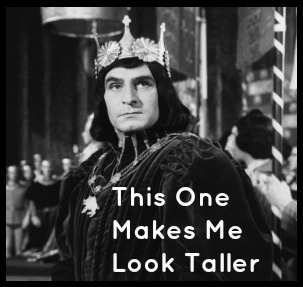 Over on Hoyden About Town, a post on the hits and misses of the latest crop of kids movies turns into a fun discussion as a bunch of commenters (including me!) pile on in a GOOD way to defend Wreck It Ralph’s positive portrayal of female characters.
Over on Hoyden About Town, a post on the hits and misses of the latest crop of kids movies turns into a fun discussion as a bunch of commenters (including me!) pile on in a GOOD way to defend Wreck It Ralph’s positive portrayal of female characters.
The Sleeps With Monsters series at Tor asks, where are all the older (and old!) women in SF?
Grant reviews Chicks Unravel Time over at the Angriest. I continue to be surprised at how positively my ‘the Sixth Doctor was actually pretty awesome, and the trial scenes were the best bits’ essay is being taken. I kind of thought it would be controversial…
Marianne De Pierres announced that her goth glam YA series The Night Creatures (Burn Bright, etc.) will be available to the REST OF THE WORLD in e and paperback later this year, via Amazon.
At Bitch Magazine, a class of teenage girls talk about their current feminist celebrity heroes. The girls are pretty cool but I totally want their teacher for any school my daughters go to.
Kathleen Jennings, the Australian artist that everyone should be paying attention to, has posted about the process of some of her illustrations for new online fiction magazine Eclipse.
On the Smell of Books, a post about the future of editing and how the profession is going to have to toughen up a bit with the scary times ahead, but will ultimately survive. As long as they take Microsoft Word into their heart. That was the message, right?
In conclusion, there is a Monster at the End of the Internet. DON’T LOOK! You’ll only encourage it.
February 6, 2013
Where the Wonder Women Are: #35 Big Barda
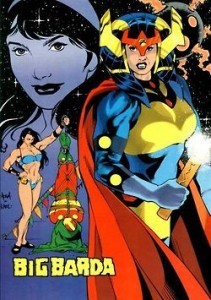 When I first met Scott and Barda Free, they were living a life of domestic bliss, occasionally punctuated by explosions and the other side effects of having a superhero in the family. Scott went off to his day job as Mister Miracle, stage escapologist and member of the Justice League International, and Barda stayed home to do the housework.
When I first met Scott and Barda Free, they were living a life of domestic bliss, occasionally punctuated by explosions and the other side effects of having a superhero in the family. Scott went off to his day job as Mister Miracle, stage escapologist and member of the Justice League International, and Barda stayed home to do the housework.
The twist was, if she wanted to bench press the house, she pretty much could.
This era is often panned by Barda fans, and I can see why – she’s a mighty space warrior, acting out a slightly less sexist (but only slightly) version of Bewitched, with no apparent desires beyond a simple, gender essentialist life as a housewife. She’s often reduced to the role of Her Indoors, hosting a barbecue for Scott and his superhero friends, or nagging him about getting home in time.
When she finally does strap her space armour back on and go into battle, it’s to rescue her husband rather out of a general sense of identity or completion. It could certainly be argued that from a character point of view her, identity revolves entirely around rescuing her husband. Which is… both problematic and awesome? Problamatawesome?
Scott is certainly no Darrin or Ricky Ricardo or any of those other sitcom husbands who were seriously holding back their awesome wives. We never see Scott express anything but admiration for his wife’s skills. He enjoys being rescued by her, and while they play out the ‘woman knows best, bloke is a bit useless’ routine, it’s their routine and it is much closer to equality than most marriages we see in comics.
It’s actually REALLY rare that superhero marriages where both the parties are super-powered are allowed to last.
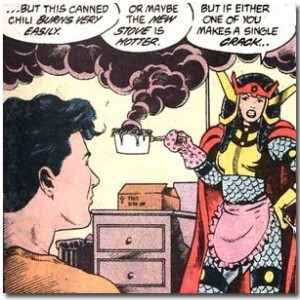 Scott and Barda’s marriage is, if gender essentialist in its trappings, constantly subverting the idea of a sitcom marriage – and in the 1980’s sitcom marriages were still pretty much tied up in traditional gender roles. Sure, Alyse Keaton of Family Ties and Angela of Who’s the Boss had real jobs, but they were still being held to very old fashioned ideas in the home, having to overcome them on a daily basis.
Scott and Barda’s marriage is, if gender essentialist in its trappings, constantly subverting the idea of a sitcom marriage – and in the 1980’s sitcom marriages were still pretty much tied up in traditional gender roles. Sure, Alyse Keaton of Family Ties and Angela of Who’s the Boss had real jobs, but they were still being held to very old fashioned ideas in the home, having to overcome them on a daily basis.
So, Scott and Barda. A lovely couple. Did I mention she is taller than him? A minor detail perhaps, but how rarely does this happen in visual media? And there’s nothing minor about the fact that she is also physically stronger and more badass than her husband at every turn.
Sure, she isn’t seen as a main protagonist for most of this era, and rarely appears in the story except to further Scott’s storyline (apart from a brief subplot in which she is called in to help Fire control her explosive new powers) but Barda is still completely and utterly fantastic.
So where on earth did she come from? I picked up bits and pieces about the backstory of the New Gods from this very comic, but was never very clear on the big picture. Did I mention we didn’t have Wikipedia back in the 90’s? HOW WE SUFFERED.
 Barda began life as a supporting character in the Mister Miracle comic back in 1970, created by Jack Kirby. This series and its “Fourth World” sequels before the late 80’s were all fairly short-lived, each delving into the intergalactic space opera of the diplomacy and wars between New Genesis (home of the New Gods), and the horrific, evil empire planet that is Apokolips, ruled by the tyrant Darkseid.
Barda began life as a supporting character in the Mister Miracle comic back in 1970, created by Jack Kirby. This series and its “Fourth World” sequels before the late 80’s were all fairly short-lived, each delving into the intergalactic space opera of the diplomacy and wars between New Genesis (home of the New Gods), and the horrific, evil empire planet that is Apokolips, ruled by the tyrant Darkseid.
The true heir of New Genesis, Scott Free was swapped as a baby with Orion, Darkseid’s own son, in the name of diplomacy – but was raised in the charmingly named Terror Orphanage (take that, Harry Potter) run by Granny Goodness.
Basically, if Mom from Futurama decided to trade in orphans rather than robots, you’d get Granny Goodness. She’s a brilliant, awful villainess who should be used far more than she is, even if she does play on the rather uncomfortable trope of ‘lady in nurturing role is actually horrible, therefore Worst Person in the World’ – hard to argue with, but hardly original even in the 70’s.
Scott became a rebel on Apokolips, joining a secret group of revolutionaries, and met Big Barda, who was also looking for a better life than what Granny Goodness and Darkseid offered.
Barda was being groomed by Granny to lead her evil (everything on Apokolips is basically evil) Female Fury Battalion (as a classicist I do object to the apparent need to specify that the Furies are female), but instead chose love, helping Scott escape to Earth.
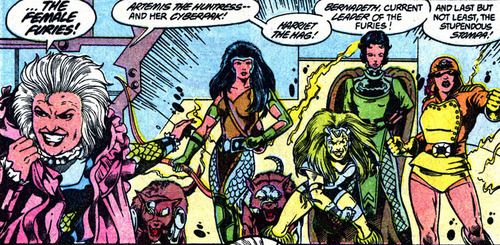
This would actually be the pattern of their relationship – him needing help, her protecting him. He is her little sweeties and she wants to keep him safe. In short, he’s the damsel of the couple. It’s pretty great.
On Earth, Scott was adopted by a circus (of course) and was mentored by the original Mister Miracle, learning the skills greatest escapologist in the world. Which is actually a pretty good skill if you’re going to spend most of your adult life being captured on a hell planet, and rescued by your girlfriend/wife.
Eventually, Barda followed Scott to Earth with her Battalion, after he had taken on the name of Mister Miracle. She and the Furies helped him take his show on the road, and they were eventually married.
Scott and Barda Free tried retirement, from cosmic disasters as well as show business, settling down in the little town of Bailey, New Hampshire, along with (strangely) Scott’s best friend from the circus, a grumpy dwarf (I’m not making this up) called Oberon.
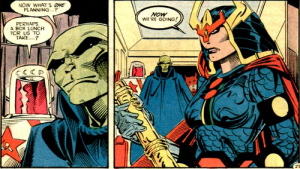 Which brings us to the years of Justice League domesticity. A new Mister Miracle title spun off from the successful JLI in 1989, and continued for some time, often crossing over into the group title – and while they had plenty of cosmic shenanigans, the premise of the comic was very much the real, everyday adventures of the two of them as a married super couple in suburbia. Much humour came from Barda’s alien ways and her not always getting the hang of basic human traditions, but desperately wanting to. In some ways, this felt a bit more like I Dream of Jeannie than I Love Lucy or Bewitched.
Which brings us to the years of Justice League domesticity. A new Mister Miracle title spun off from the successful JLI in 1989, and continued for some time, often crossing over into the group title – and while they had plenty of cosmic shenanigans, the premise of the comic was very much the real, everyday adventures of the two of them as a married super couple in suburbia. Much humour came from Barda’s alien ways and her not always getting the hang of basic human traditions, but desperately wanting to. In some ways, this felt a bit more like I Dream of Jeannie than I Love Lucy or Bewitched.
The main thing is choice. Barda wanted a domestic, peaceful life, and after her background that’s hardly surprising. She would strap on her warrior armour when necessary, but playing the housewife made her happy. And that’s okay, actually. Except, of course, that it never quite went right…
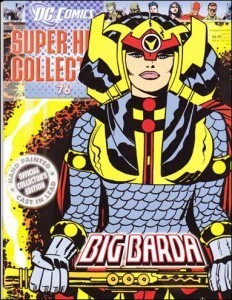 Let’s talk about Barda as a warrior. She’s a massive woman, and most artists respected that, drawing her with solid bulk, muscle and height. Not quite She-Hulk stature, but not far off. She was also usually drawn in physical contrast to her husband, as an essential character note for them both.
Let’s talk about Barda as a warrior. She’s a massive woman, and most artists respected that, drawing her with solid bulk, muscle and height. Not quite She-Hulk stature, but not far off. She was also usually drawn in physical contrast to her husband, as an essential character note for them both.
(Except in the cartoon Justice League Unlimited where she is weirdly tiny – and of course Li’l Barda in Tiny Titans, which is fair enough really)
She not only has super strength, endurance, reflexes and speed (and longevity) she’s also the master of several weapons, not least the Mega-Rod which is, well. MIGHTY. And allows her to teleport herself and others through the excellent sounding Boom Tubes.
My favourite thing about Barda, though, is the combination of her strength and power with humour. Her character was not just allowed to be witty and snarky, but also to take part in physical humour.
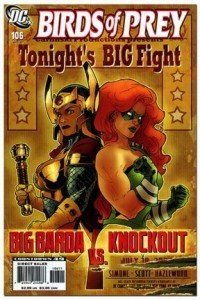 While Scott and Barda eventually left the Justice League – leaving Oberon to continue the role he had taken on as Maxwell Lord’s main sidekick – she later returned to super heroics more actively in her own right. Barda was not only a member of the more “serious” Justice League of the early 2000’s, but also joined the Birds of Prey after invited by Oracle to be their “heavy hitter.”
While Scott and Barda eventually left the Justice League – leaving Oberon to continue the role he had taken on as Maxwell Lord’s main sidekick – she later returned to super heroics more actively in her own right. Barda was not only a member of the more “serious” Justice League of the early 2000’s, but also joined the Birds of Prey after invited by Oracle to be their “heavy hitter.”
Oh, and then they killed her.
You knew this was coming, right?
To be fair, her death came as part of a mini-series called Death of the New Gods (2007-2008), so it’s not like Barda was being singled out. Right?
The writer/artist of the mini-series, Jim Starlin, admitted that he thought that it was important to bring an end to this particular branch of the DC universe, as it had been portrayed with “mixed results” since being created by Kirby and that he considered it a “mercy killing.” Which doesn’t sound to me like the most positive reason in the world to create a comic event, but hey don’t mind me, I’m still bitter and resentful about what happened to Blue Beetle, Maxwell Lord, and pretty much every character who ever featured in JLI and its spin off comics. Crimson Fox, anyone? Fire and Ice? Ralph and Sue Dibny? (Don’t worry, I’m getting to them)
In any case, Barda is killed by a New-God-specific serial killer. In her kitchen. “While her husband’s back was turned,” according to descriptions – I haven’t personally read these comics, nor am I particularly keen to.
I’m not quite sure why it’s significant that his back is turned, except of course that it’s clear Barda’s death was used to create excessive man pain in her husband, one of the main active characters in this series along with Orion (whose wife was also killed in this story arc) and Superman. The whole story sounds pretty messy and sordid, and ends up with Scott Free feeling devastated and betrayed by the Source of the New Gods (and cause of their deaths) requesting to join his dead friends and family, which is granted.
So, um. Cheerful story, then. VERY in the traditions of Jack Kirby, I don’t think. More and more I begin to think that the people who talk about a conspiracy to wipe out and do horrible things to all the ‘fun’ characters of the late 80’s and early 90’s in DC Comics might be on to something.

This is where, of course, the DC reboot actually comes in handy. Big Barda has not shown up in the new continuity yet (unless I have missed something? I’m way behind on my reading) but the New Gods have started to make sneaky inroads into the excellent Cliff Chiang/Brian Azzarello Wonder Woman title, and so I’m hoping, hoping, HOPING that our girl gets a comeback.
Scott can come too, if he likes. But this time around he doesn’t have to be the headline attraction.
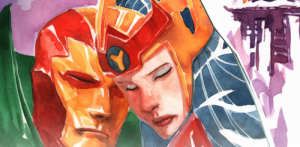 Meanwhile, the Digital Only DC Comics (which all work on separate continuities) are making the most of getting to choose what universe they inhabit. This seems to be particularly good for fans of female characters who are being screwed over by the current continuity – many fans of Lois Lane, for instance, are finding more to like about the Smallville comic than any ‘real’ Superman title.
Meanwhile, the Digital Only DC Comics (which all work on separate continuities) are making the most of getting to choose what universe they inhabit. This seems to be particularly good for fans of female characters who are being screwed over by the current continuity – many fans of Lois Lane, for instance, are finding more to like about the Smallville comic than any ‘real’ Superman title.
Big Barda is currently featuring in two separate digital continuities – she is a regular team member in Justice League Beyond (part of the futuristic Beyond universe where Terry McGinnis is the new Batman, with an elderly Bruce Wayne as his mentor) and recently had her own origin issue (Chapter 16) which explained how she ended up alone on Earth, exiled from her people and separated forever from Scott.
The fun and irreverent Ame-Comi Girls also recently featured a little standalone story (Chapter 22) which places Big Barda in the context of their just-the-super-ladies universe.
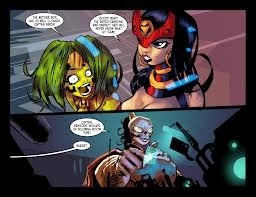 In case you were wondering, Barda is of course a space pirate with a ship full of mostly loyal Female Furies, fighting not only Granny Goodness (and the disturbingly named Wombworld) but the sinister Lady Darkseid too.
In case you were wondering, Barda is of course a space pirate with a ship full of mostly loyal Female Furies, fighting not only Granny Goodness (and the disturbingly named Wombworld) but the sinister Lady Darkseid too.
Tantalisingly, Mr Miracle is in this universe too… except of course, she is Miss Miracle. OH HELL YEAH. If you want to know as badly as I do whether their love is as true and eternal in this continuity as in the others… I honestly can’t tell. There is one very friendly hug which could mean anything, but oh. I’m really hoping we see more of the Ame-Comi Barda and Miracle in the future, because if they are not in love I MIGHT HAVE TO WRITE OFFICIAL LETTERS OF COMPLAINT.
True fact: I had not realised how much I ship Barda and Scott until writing this essay.
Barda and Scott forever.
Or, if Ame-Comi Girls is the only one doing it right, Barda and Scottlene forever.
Where the Wonder Women Are:
0: Introduction
1: Black Canary
2: Rogue
3: Hawkgirl/Hawkwoman
4: Black Widow
5: Wonder Girl
6: Captain Marvel
7: Vixen
8: Abigail Brand
9. Jubilee
10. Batwoman
11. Catwoman
12. Huntress
13. Robin
14. Batgirl
15. Jean Grey
16. Ice
17. Emma Frost
18. Fire
19. Lady Sif
20. Supergirl
21. The Wasp
22. Gypsy
23. Misty Knight (and Colleen Wing)
24. Mystek
25. Kitty Pryde
26. Crimson Fox
27. The Invisible Woman
28. Dr Light
29. Hawkeye
30. Maya
31. Nico Minoru
32. Karolina Dean
33. Gert Yorkes/Arsenic & Old Lace
34. Molly Hayes/Bruiser
February 4, 2013
Teeth and Curls [WHO-50—1975]
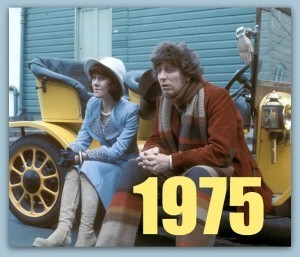 A new production team, a new TARDIS team, everything old is new again! Tom Baker’s Doctor is still seen as the definitive take on the character, and 1975 was the beginning of a swell of mainstream recognition for the show such as had not been seen since the Dalekmania days a decade earlier. It’s telling that to many casual viewers and non viewers, “the one with the scarf” is the Doctor they remember.
A new production team, a new TARDIS team, everything old is new again! Tom Baker’s Doctor is still seen as the definitive take on the character, and 1975 was the beginning of a swell of mainstream recognition for the show such as had not been seen since the Dalekmania days a decade earlier. It’s telling that to many casual viewers and non viewers, “the one with the scarf” is the Doctor they remember.
Tom Baker strode into the role like he had been born to play it, bringing a wave of genuine eccentricity which only added to the idea that the Doctor was an alien, favourite uncle and naughty schoolboy all rolled into one.
It’s hardly surprising that many fans remember a story from 1975 as the start of their devotion – not only were some of the best stories of all time screened in this year, but viewers were treated to nearly two whole seasons of Doctor Who.
First, five linked stories that are all firmly science fictional in Season 12, featuring giant robots, space stations (okay the same space station twice), Cybermen, Sontarans and Daleks.
Then, after only a three and a half month break, Season 13 began, with four of its six serials screening before the end of the year. The ‘gothic horror’ tone associated with this production team was beginning to creep in during this later block, notably in the story Pyramids of Mars, though there were still plenty of aliens and robots. The *most* gothicky stories of this season (Brain of Morbius and Seeds of Doom, which cover almost all the traditional horror tropes between them) would not screen until early 1976.
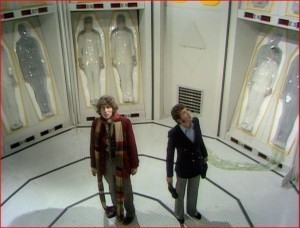 Looking at 1975 as a body of Doctor Who, it’s clear that they were going for a harder combination of science fiction than had been seen before, and already starting to play with the horror toolbox. The format of the show was shaken up too – the TARDIS was brushed aside as the Doctor’s primary mode of transport for a good chunk of Season 12 in favour of a Time Ring, and the Time Lords began to take a far greater interest in what the Doctor could do for them.
Looking at 1975 as a body of Doctor Who, it’s clear that they were going for a harder combination of science fiction than had been seen before, and already starting to play with the horror toolbox. The format of the show was shaken up too – the TARDIS was brushed aside as the Doctor’s primary mode of transport for a good chunk of Season 12 in favour of a Time Ring, and the Time Lords began to take a far greater interest in what the Doctor could do for them.
Joining Sarah (the ‘Jane’ in her name seemed to fall away to make room in the TARDIS) was Harry Sullivan, a young and easily-embarrassed medical Doctor who added a great deal of gentlemanly slapstick to the proceedings, and whose old fashioned style and turn of phrase made a splendid contrast to Sarah’s more modern attitudes.
Much is often made of Harry being a ‘return’ to the old black and white days (a whole five years ago!) in which the older Doctors were accompanied by younger ‘action men’ to do the heavy lifting and other Heroic Bloke action. It’s been said that they were planning to cast a less-fit-than-Pertwee older Doctor again, and that Harry was written in to allow for that.
I’m not convinced that this was an especially different change, though. I still have trouble classifying the Brig, Benton and Yates as male ‘companions’ of the Doctor – like many others, my views on this were shaped at an impressionable age by a bunch of Peter Haining reference books in the 1980’s – but there’s no denying that the Doctor had recurring male regulars in the ensemble around him through the Third Doctor years (only 10 of Sarah Jane’s 26 episodes with Pertwee did not feature UNIT, and only one of Jo’s three seasons as companion had the ‘away’ serials outnumbering the ‘home’ ones).
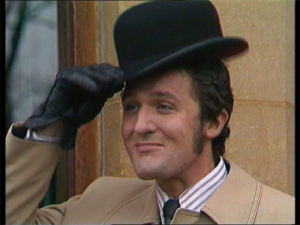 A male companion offers a lot more than a conveniently violent pair of fists, though Doctor Who never did much to capitalise on the romantic possibilities of having a young male companion alongside a female one – apart from the vaguely tragic romance of Jamie McCrimmon and Victoria Waterfield. Harry Sullivan in fact hardly has to be explained at all – he wasn’t unusual in the traditions of the show thus far, but certainly was in comparison with what was to follow. After Harry left in early Season 13, the Fourth Doctor continued with only a female companion (and occasional robot dog) for the majority of his seven year run.
A male companion offers a lot more than a conveniently violent pair of fists, though Doctor Who never did much to capitalise on the romantic possibilities of having a young male companion alongside a female one – apart from the vaguely tragic romance of Jamie McCrimmon and Victoria Waterfield. Harry Sullivan in fact hardly has to be explained at all – he wasn’t unusual in the traditions of the show thus far, but certainly was in comparison with what was to follow. After Harry left in early Season 13, the Fourth Doctor continued with only a female companion (and occasional robot dog) for the majority of his seven year run.
I’d suggest that the brushing aside of the relevance of a male companion had little to do with scriptwriters or even the heroic qualities of the leading man – what it comes down to is that for some reason, the concept of the Doctor and his companion as male and female leads, needing no one else, has become the iconic image of what Doctor Who looks like in the eyes of the public and the media. The mini-skirted women of the Pertwee era (and the reduction of the role of the male regulars) helped this idea along a lot, but it was the the late 1975 stories with Sarah and the Fourth Doctor striking off on their own that really began to forge this image.
UNIT themselves feature in three stories during 1975, punctuating the more space-ey adventures, and reminding us of the format that was the standard only a year previously.
Robot, often dismissed by fans as a leftover Pertwee story with the wrong Doctor in it, serves to introduce the Fourth Doctor marvellously as a fish-out-of-water, and to shake up the preconceptions of Sarah and the Brigadier as well as the audience about what exactly the Doctor is likely to do in a given situation.
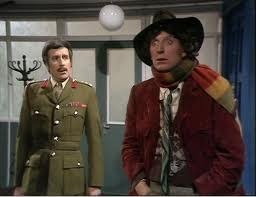 It’s not accidental that this story pokes at our expectations, and that the series regulars get to show over a series of reactions that this Doctor is a new man that they don’t entirely know or trust. I particularly like the fact that Sarah moves on without the Doctor in this story, getting on with her life and journalistic career during his post-regenerative coma, but also distancing herself from him once he is awake and acting like a lunatic. He’s not her Doctor any more, after all – he’s a stranger, and for the first time a companion gets to deal with this on her home turf.
It’s not accidental that this story pokes at our expectations, and that the series regulars get to show over a series of reactions that this Doctor is a new man that they don’t entirely know or trust. I particularly like the fact that Sarah moves on without the Doctor in this story, getting on with her life and journalistic career during his post-regenerative coma, but also distancing herself from him once he is awake and acting like a lunatic. He’s not her Doctor any more, after all – he’s a stranger, and for the first time a companion gets to deal with this on her home turf.
When Sarah leaves with the Doctor at the end of the story, it’s a new choice all over again – and that choice is to have an adventure, not to sign up for years and years (as ends up being the case). Likewise, when Sarah, Harry and the Doctor meet up with the Brigadier and UNIT again in Terror of the Zygons (at the beginning of Season 13), Harry has learned a lesson and refuses to step back into the TARDIS. Like Ian and Barbara, he figures this might be his only chance to jump ship.
Sarah agrees to go with the Doctor one last time (heh) but only on condition that they go straight back to London – something that the Third Doctor would have managed after perhaps only one or two wrong turns. The Fourth, however, takes this as a license to show her the universe all over again…
Ah, Sarah. You keep saying no and then going back one more time.
 The final story of 1975, The Android Invasion, is one of my favourites – sadly it doesn’t quite work as the farewell to UNIT that it could have been if Nicholas Courtney had been available (the Brigadier instead is mysteriously ‘in Geneva’, a tradition that certainly had its uses over the years) but we do get a swan song for Benton and Harry, even if they aren’t quite as Sarah remembers them.
The final story of 1975, The Android Invasion, is one of my favourites – sadly it doesn’t quite work as the farewell to UNIT that it could have been if Nicholas Courtney had been available (the Brigadier instead is mysteriously ‘in Geneva’, a tradition that certainly had its uses over the years) but we do get a swan song for Benton and Harry, even if they aren’t quite as Sarah remembers them.
The Android Invasion is a greatly underrated story, which gives Sarah some meaty material and the Fourth Doctor some of his most quotable lines – is it unfair to note that Terry Nation did some of his best writing when script edited by Robert Holmes? The unsettling effect of an English village in which everything is quaint and detailed but ever so slightly wrong comes across very well, but more to the point, it shows that the Doctor and Sarah can take on a story like this in their own style and that UNIT are (sadly) not needed any more.
Also this story gave us Tom Baker saying the word ‘ginger beer.’ Your argument is invalid.
Robot and Terror of the Zygons showed that the Fourth Doctor was a lot more unpredictable and less of a cozy team player than his predecessor – but it is The Android Invasion that draws a line under UNIT once and for all as something that belongs in the Doctor’s past.
By the end of 1975, despite Sarah making the occasional complaint and protest about never getting home, she is firmly installed as a TARDIS resident rather than visitor (including, as we would eventually learn, her own potplants and soft toys). Harry has had his adventures and firmly waved goodbye to them both. Doctor Who as a show now enters a whole new phase – one which would prove the most memorable of the entire Classic series. No pressure or anything!
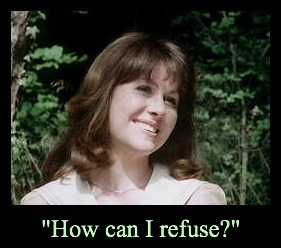
ELSEWHERE IN 1975:
A Modern Woman’s Guide to Classic Who: The Fourth Doctor Years 1975-1981 [tansyrr.com]
4th Doctor Tom Baker art [Springfield Punx]
Fourth Doctor art [Marlow Inc]
Born to be Alien [Tor.com]
Retro View: Robot [NeoWhovian]
Bumbling But Well Meaning: Harry Sullivan art [Marlow Inc]
Genesis of the Daleks [Mindless Ones]
Genesis of the Daleks [Classic Who Conversations]
Terror of the Zygons [the Angriest]
The Android Invasion [the Independent]
Pub Kraal [NeoWhovian]
@WeTasmania, Cupcakes and More.
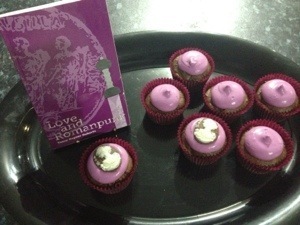 In a surprise plot twist, I will be taking over the @WeTasmania tweetstream for a whole week starting tomorrow.
In a surprise plot twist, I will be taking over the @WeTasmania tweetstream for a whole week starting tomorrow.
Follow the account for my adventures in The First Week School Is Back. The idea behind the account is for Tasmanians in different parts of the state to share their world with, well, the universe. Here’s a spoilerific hint: my world is going to involve a lot of iced tea and typing. I HOPE.
For the occasion I will also learn how to Twitpic. Yes I’m almost certain that’s a verb. BE WARNED.
In other exciting domestic adventures, the astounding Terri has started back blogging about the awesome book-themed cupcakes she made for the Twelfth Planet Party at Continuum last year and all the other cupcakes can go home now, because she has put up a post about MY LOVE AND ROMANPUNK CUPCAKES.
It’s actually been a week for cupcakes because I invented black forest cupcakes for my honey’s birthday, but let’s move on, shall we?
Over on the Verity! podcast, they made an episode without me (pout!) which involved some fascinating discussion about the Tenth Doctor, and particularly the negative perception of “Tennant Fangirls”, and geek girls in fandom in general.
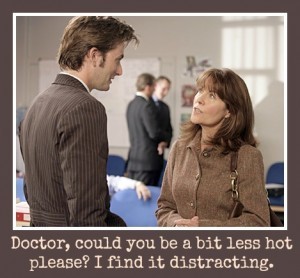 I got to write a “My Two Cents Post” AKA what I was yelling at the air while listening to the podcast going on without me, and addressed my own issues with School Reunion, and why it’s impossible to imagine that Sarah Jane fancied Tom Baker, but I’m okay with her fancying David Tennant. A bit.
I got to write a “My Two Cents Post” AKA what I was yelling at the air while listening to the podcast going on without me, and addressed my own issues with School Reunion, and why it’s impossible to imagine that Sarah Jane fancied Tom Baker, but I’m okay with her fancying David Tennant. A bit.
Please note: every time there is a complaint in the comments that the Verity! podcast or blog is making het male fans uncomfortable by acknowledging the relative hotness of Tennant (or indeed any other Doctor), I am totally going to post a picture of Turlough wearing short shorts in Planet of Fire. IT IS RELEVANT TO THE CONVERSATION.
Oh, and my slightly less regular Doctor Who podcast, the companion piece to our Doctor Who in conversation blog series (with David McDonald and Tehani Wessely) is discussing Genesis of the Daleks this week for our Episode 2. Sadly Daleks appear to have attacked Skype, which is the only explanation we can offer for the very dodgy sound quality.
February 3, 2013
On My iPod: Memory Boxes, Doctorish Destinies & Blake’s 7 Returns
 I’ve been listening to a LOT of audio plays and podcasts lately, what with all that cleaning for birthday parties, sewing birthday presents, and drowning out my children during the last gasp of the summer holidays.
I’ve been listening to a LOT of audio plays and podcasts lately, what with all that cleaning for birthday parties, sewing birthday presents, and drowning out my children during the last gasp of the summer holidays.
VIENNA: THE MEMORY BOX is the first story of a new spin off series from Big Finish, featuring bounty hunter and space assassin Vienna Salvatori (played by former DS9 actress Chase Masterton). My first reaction to this series, naturally, was to resent that it was greenlit and written so quickly when SOME OF US have been waiting for the Charley Pollard spin off series FOREVER, but Vienna is a fun, banterific character and I liked this first (standalone) story very much, with its planethopping, space hotels, twisty turny plottiness, and great voice performances.
This particular story revolves around a piece of technology called a ‘memory box’ which allows people to store and conceal layers of memory – an essential tool for those with criminal intent in a galaxy where the police have the ability to scan people’s minds at the scene of a crime. I was impressed with how many different ways this particular gadget was used and abused over the course of the story, making it a tidy piece of science fiction. Plus, adorable space cops. SPACE COPS, PEOPLE!
If you’ve been following the many, many reveals about Doctor Who anniversary releases, you might have heard about DESTINY OF THE DOCTOR, a series of audiobooks co-produced by AudioGo and Big Finish featuring each of the Doctors in turn. While the majority of publicity for this series came from the fact that it meant Big Finish finally got their hands on New Who content (in a limited way) and that it meant new material involving (in some way) Eccleston’s 9th Doctor (but not necessarily Eccleston), what hasn’t really been discussed further is that they seem to be picking bits of each era that have a great significance and haven’t necessarily been written about before. The upcoming audiobook for the Third Doctor era, for example, features Mike Yates and tells the story of his first adventure with the Doctor and the Brigadier.
The first in this series, Hunters of Earth, features Carole Ann Ford and Tam Williams and is set in 1963 London before An Unearthly Child. Here we see something of Susan’s schooldays, and the growing rift between herself and her grandfather The Doctor as he furiously repairs the TARDIS ready for their next journey, as she longs more and more to put down roots and stay somewhere permanently. We also get to see her interact with other teenagers, particularly a certain boy she quite likes. The clever part of the story, though, is that it also holds a conversation with that other 1963 set Doctor Who adventure, Remembrance of the Daleks, foreshadowing much of the anti-immigration, racist sentiment that was to be such an important thematic note of that particular story.
I don’t often listen to the early TARDIS crew audiobooks, largely because the lack of Barbara hurts my soul, but this is a very good use of Carole Ann Ford’s voice and fills in a little piece of unexplored Who history. yes, there are still some of those! Also it’s a very good price at only $5 for download. Definitely a series to keep an eye on.
A new podcast I’m currently listening to and loving is Decompressed by Kieron Gillen, in which the comics writer chats with his mates about process and the industry. The episodes with Kelly-Sue Deconnick and Matt Fraction/David Aja are particularly good, but I’ve liked most of them in actual fact. Very cool stuff.
 Finally, there’s the new Blake’s 7… Warship!
Finally, there’s the new Blake’s 7… Warship!
Big Finish have had the rights to make original Blake’s 7 material for the last year, and have put out some novels and two-hander audiobooks, but this is the first full cast story they have made – and cleverly they chose a very important period to flesh out, that being the gap between Seasons 2 and 3. Season 2 ends on the cliffhanger of Avon shouting ‘fire’ as they face down the alien invasion… and Season 3 skips ahead to the crew of the Liberator evacuating the ship (and then slowly making their way back, minus a couple of key members of the crew) without bothering to film all that messy alien battle business. Gah!
Warship doesn’t quite live up to my hopes, not least because they are making more stories in this time gap, so it doesn’t come close to answering most of my questions about this gap. It’s also not quite as epic and massive a story as I was expecting from the build up – it feels, actually, like an authentic missing episode with a slightly bigger budget. But that’s no bad thing at all. It’s LOVELY to hear the crew back and riffing off each other, especially to hear Sally Knyvette as Jenna, the only character of the original crew (with a living actor) not brought back to the audiobook range so far. She’s one of my favourites and probably the character who was least well served by the original show (she’s a smuggler and a devastating pilot, write material for her, damn it!) so I’m glad she’s no longer being ignored.
(I also love that Sally Knyvette is adamant that Blake was lying when he said Jenna died offscreen – screw that for a joke! And if Big Finish want anyone to write THAT particular story, I’d be happy to volunteer)
But yes, it’s a very good piece of Blake’s 7, perhaps my favourite so far from the new range (though some of the Liberator Chronicles two-handers are very good especially in writing for Avon and Cally). While part of me wants it to be massive and groundbreaking and NEW in the way that Big Finish has developed the Doctor Who universe, I also have to accept that this is early days, and ‘authentic, but with slightly more space stuff and more lines for the girls to say’ is a pretty awesome place for Big Finish to start with New Blake’s 7.
Oh and for those who don’t get into audio drama (remind me, why are we still friends?) there is also an ebook novelisation of this one.
More please.
I have to say, though, after recently reading Avon: A Terrible Aspect, (which among other things establishes at great length just how awesome in bed Avon’s Dad was) I am a *touch* concerned that they are putting ‘what happened after the show ended’ storyline in the hands of Paul Darrow with the upcoming book Lucifer. Concerned, wary and very curious.
But hey, as long as there are spaceships, black leather and snarky remarks, we should be okay, right? Right?
Australia Day Book Giveaway Blog Hop Love and Romanpunk winner!
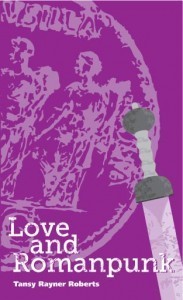 Wow, that’s a mouthful. Thanks so much to everyone who entered the contest. It was lovely to read all the answers – I do love monsters and such a variety. A shame there can only be one winner, but for those who expressed genuine anguish at the thought of not getting a print copy of my cute little purple book, apparently there ARE still copies for sale at Slow Glass Books in Melbourne and yes, they do mail order – slowglass.com.au
Wow, that’s a mouthful. Thanks so much to everyone who entered the contest. It was lovely to read all the answers – I do love monsters and such a variety. A shame there can only be one winner, but for those who expressed genuine anguish at the thought of not getting a print copy of my cute little purple book, apparently there ARE still copies for sale at Slow Glass Books in Melbourne and yes, they do mail order – slowglass.com.au
If anyone knows of other bookshops that still have copies, do link to them in the comments!
The range of monsters loved by people was marvellous to see – most popular ones included Frankenstein, Count Dracula and Cthulu – it’s good to respect the classics. I also was geekily delighted to read recs for Cookie Monster, the Sphinx, and several literary, film and mythological monsters.
(No one said manticore, though. sniff. Maybe once you’ve read the book you’ll change your mind!)
The selection, however, is entirely random, so without further ado the winner is… (drum roll)
KIRSTEN W
with: “wendigos”
this monster also comes with bonus kudos for being the only one I actually had to look up.
Thanks for entering, everyone! Kirsten, please email me at tansyrr (at) gmail.com with your postal address and I will send you your prize!

